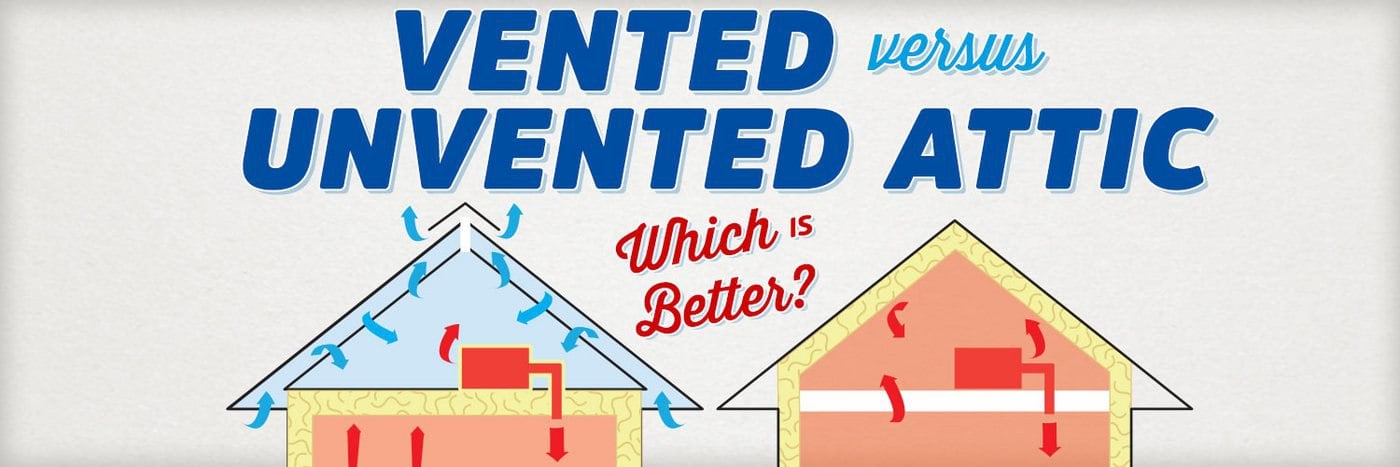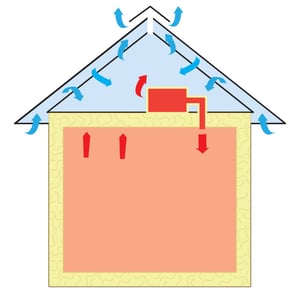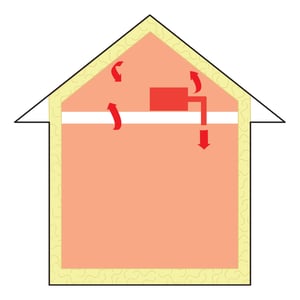Vented vs. Unvented Attic: Which is Better?


You’re looking to re-insulate your attic with spray foam because you’re tired of losing money right out through the roof, but there are just a few more things to consider.
Those things you need to consider are whether you plan to have a vented or unvented attic system. Are you wondering what that means? We've got you covered.
RetroFoam of Michigan has more than 17 years of experience insulating thousands of homes across the lower peninsula and greater Toledo area. With this experience comes the knowledge of the benefits of vented and unvented attics.
We are on a mission to give homeowners all of the information they need to make the best decision for their home's insulation needs. As part of that mission, below, I will discuss the vented attic system and the unvented attic system, as well as the pros and cons of each.
Vented vs Unvented Attic: What's the Difference?
You're here to figure out which attic system is best for your home, but it's also important to understand how each system works.
When insulating your attic, the contractor can either spray the attic floor to keep a vented attic or spray the roof deck for an unvented system.
Let's dive a little deeper into what that means exactly.
A vented attic system refers specifically to having working vents in the attic. For example, in the summer months, your attic is likely going to be very hot. Those vents in the attic allow for airflow, and that airflow moves the hot air and moisture out of the attic.
Spray foam insulation in vented attics will resist any heat transfer from that airflow, so you don't have to worry about the rest of your house getting hot as well.
An unvented attic system relies on an air seal and no vents to make the attic a conditioned space. By using an air-impermeable insulation, like spray foam, on the roof deck will stop any air movement. If the home's building envelope is completely air sealed, then the air traveling up to the attic won't be unbearably hot, and there will be no need to cycle it out with vents.
It is a common misconception that one of the unvented attic problems is that the roof needs to breathe or that the insulation will make the roof hot. In reality, if spray foam insulation is used on the roof deck it could raise the temperature of the shingles a few degrees, but not enough to cause any damage.
To be more clear and help you understand the vented vs unvented attic systems, let's take a closer look at the pros and cons of each. Hopefully, this will help you determine which system is going to be best for your attic.
Spray Foam Insulation in Vented Attic Pros and Cons
 More than likely you currently have a vented attic, because it’s been the traditional way to insulate that space with cellulose or fiberglass for quite a long time.
More than likely you currently have a vented attic, because it’s been the traditional way to insulate that space with cellulose or fiberglass for quite a long time.
There are still some circumstances where having spray foam insulation in a vented attic on the floor might be the best option for your home.
Let's take a quick look at the pros and cons of the vented attic system.
Vented Attic Pros:
- If you have a high-pitched roof, the vented attic system may make the most economic sense since there is less area to spray the foam.
- Many homes already have attic vents in place that can be used.
Vented Attic Cons:
- Because the attic won't be a conditioned space, you won't be able to use it for storage.
- Your attic will have drastic temperature changes due to the airflow through the vents.
- You will need to do regular checkups on the vents to ensure they are working properly.
- This system can lead to moisture build-up.
Unvented Attic System Pros and Cons
 The unvented attic system, or conditioned attic, is the new way to make your attic energy efficient.
The unvented attic system, or conditioned attic, is the new way to make your attic energy efficient.
Unvented Attic Pros:
- Adding unvented attic insulation, like spray foam, seals the building envelope and stops airflow. This air seal will help to make your home more energy-efficient.
- Making the attic a conditioned space means the space will be the same temperature as the rest of your home. You can convert it to a living space or storage area.
- This system can help you avoid condensation in the attic.
- If the home has any mechanicals in the attic, like HVAC or ductwork, the unvented attic system will keep it protected.
- An unvented attic system works to prevent ice dams, which can cause serious damage to your roof.
Unvented Attic Cons:
- There are some roofing companies that will void a shingles warranty if the roof deck is insulated with spray foam. It's an old-school way of thinking that the foam will cause the shingles to get hot and curl. While this isn't the case and many shingle manufacturers have written an addendum to their warranty to allow for an unvented system, it's a good idea to check with your roofing contractor.
- An unvented attic system can be more expensive when it comes to the spray foam insulation. This is because there is more area to spray, which means more cost.
Sealed Attic vs Vented Attic: Which is Best for Your Home?
Choosing a conditioned attic vs unconditioned attic space comes down to what you want to do with the area and what works best with the design of your home.
If you want the extra storage and don’t want to take the risk of moisture buildup, the unvented system is the best fit for your home. A high-pitched roof lends itself to a vented system and will still work to reduce air leakage in your home.
If you’re not sure which system will work best in your home, give us a call at 866-900-3626 or fill out the form on our website to schedule a free in-home estimate. If you'd like to learn more about what foam insulation has to offer for your entire home, check out the Learning Center on our website.
Related Articles
Open Cell or Closed Cell Spray Foam: Which is Best for the Attic and Roof?
What is the Best Insulation for an Attic? (Spray Foam vs Fiberglass vs Cellulose)
Spray Foam Attic Floor or Rafters: Which is Best to Insulate?
Save
Save
About Amanda Ringler
Amanda previously has worked as a breaking news and crime reporter, TV news producer, and editor in Flint and Detroit. Throughout her career as a journalist, she has won several awards from The Society of Professional Journalists - Detroit Chapter and the Michigan Press Association. As part of the RetroFoam of Michigan family, Amanda uses her experience as a journalist to write content that will help educate homeowners on the benefits of foam insulation. When Amanda isn’t writing, she’s spending time with her husband and rescued huskies. She also loves knitting, making art, cooking, and hosting dinner and a movie night for friends and family.

.jpg)